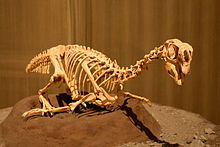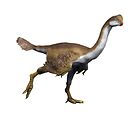Conchoraptor
| Conchoraptor Temporal range: Late Cretaceous,
| |
|---|---|

| |
| Cast mounted in a nesting position | |
| Scientific classification | |
| Kingdom: | Animalia |
| Phylum: | Chordata |
| Clade: | Dinosauria |
| Clade: | Saurischia |
| Clade: | Theropoda |
| Family: | †Oviraptoridae |
| Subfamily: | †Heyuanninae |
| Genus: | †Conchoraptor Barsbold, 1986 |
| Species: | †C. gracilis
|
| Binomial name | |
| †Conchoraptor gracilis Barsbold, 1986
| |
Conchoraptor (meaning "conch plunderer") is a genus of oviraptorid dinosaur from the late Cretaceous Period of what is now Asia.
Description[]

Conchoraptor was a small dinosaur, only 1–2 meters (3.3-6.6 feet) in length.[1] Unlike many other oviraptorids, Conchoraptor lacked a head crest.[1] Like its relatives, it lacked teeth. Instead of teeth, oviraptorids had powerful beaks, possibly adapted to crushing mollusk shells.[1] The skull of Conchoraptor was heavily pneumatised, with most of the bones hollow.[2] Internal connections between both ears functioned as resonance chambers and improved hearing.[3]
Discovery[]
When first discovered in the Red Beds of Hermiin Tsav of the Early Maastrichtian Nemegt Formation by a Polish-Mongolian expedition in 1971,[1] scientists believed that Conchoraptor was a juvenile Oviraptor and that the animal's missing crest would have begun to grow when the animal reached sexual maturity.[1] Further study of multiple skeletons showed that Conchoraptor belonged in a new genus.[1] The hands of Conchoraptor were a major reason that scientists decided to split it off from Oviraptor.[1] Anatomically the hands seemed to be an evolutionary intermediate between those of Ajancingenia and Oviraptor, making it obvious that this animal was not a member of a known species.[1]
The type species of this new genus, Conchoraptor gracilis, was described and named by Barsbold, in 1986. The generic name is derived from Greek konkhè, "mussel", and Latin raptor, "plunderer".[4] This name reflects Barsbold's hypothesis that oviraptorids, rather than preying primarily upon eggs as had been traditionally thought, may have been specialized to feed on mollusks.[1] The specific name means "gracile" in Latin. The holotype is IGM 100/20, a partial skeleton with skull. Later about two dozen specimens were formally referred to the species.
Classification[]

Conchoraptor was by Barsbold assigned to the Oviraptoridae in 1986. Recent analyses show it was a member of the oviraptorid subfamily Ingeniinae.
The cladogram below follows an analysis by Fanti et al., 2012.[5]
| Oviraptoridae |
| |||||||||||||||||||||||||||||||||||||||||||||
Paleoecology[]
Habitat[]

The Nemegt Formation of Mongolia, is estimated to date back to the Maastrichtian stage, between 70 and 66 million years ago[6] of the Late Cretaceous period.[7] During the Late Cretaceous period, the land that is now the Nemegt Formation had an arid environment with fields of sand dunes and only intermittent streams. It is slightly younger than the nearby Djadochta Formation, and seems to have been slightly wetter.[7] This formation is noteworthy for the exquisite preservation of small and fragile dinosaur skeletons, a rare occurrence considering that these fossils are typically broken up and dispersed when found in other rock formations.[8]
Paleofauna[]
Conchoraptor shared its habitat with other oviraptorosaurs including Avimimus and Nomingia, other theropods include troodontids such as Tochisaurus and Zanabazar, the tyrannosaurids Alioramus and Tarbosaurus. Ornithischians include the pachycephalosaurs Homalocephale and Prenocephale, the hadrosaurid Saurolophus, the ankylosaurs Saichania and Tarchia.
See also[]
- Nemegt Formation
Related animals
- Ajancingenia
- Timeline of oviraptorosaur research
References[]
- ^ a b c d e f g h i "Conchoraptor." In: Dodson, Peter & Britt, Brooks & Carpenter, Kenneth & Forster, Catherine A. & Gillette, David D. & Norell, Mark A. & Olshevsky, George & Parrish, J. Michael & Weishampel, David B. The Age of Dinosaurs. Publications International, LTD. p. 136. ISBN 0-7853-0443-6.
- ^ Kundrat, M. 2007, "Avian-like attributes of a virtual brain model of the oviraptorid theropod Conchoraptor gracilis", Naturwissenschaften 94: 499-504
- ^ Kundrat M. and Janacek, J., 2007, "Cranial pneumatization and auditory perceptions of the oviraptorid dinosaur Conchoraptor gracilis (Theropoda, Maniraptora) from the Late Cretaceous of Mongolia", Naturwissenschaften 94:769–778
- ^ Rinchen Barsbold, 1986, "Raubdinosaurier Oviraptoren". In: Vorobyeva, E. I. (ed.), Herpetologische Untersuchungen in der Mongolischen Volksrepublik. Akademia Nauk SSSR. pp. 210-223
- ^ Fanti F, Currie PJ, Badamgarav D (2012). "New Specimens of Nemegtomaia from the Baruungoyot and Nemegt Formations (Late Cretaceous) of Mongolia." PLoS ONE, 7(2): e31330. doi:10.1371/journal.pone.0031330
- ^ Gradstein, Felix M.; Ogg, James G.; Smith, Alan G. (2005). A Geologic Time Scale 2004. Cambridge: Cambridge University Press. ISBN 978-0-521-78142-8.
- ^ a b Jerzykiewicz, Tomasz; Russell, Dale A. (1991). "Late Mesozoic stratigraphy and vertebrates of the Gobi Basin". Cretaceous Research. 12 (4): 345–377. doi:10.1016/0195-6671(91)90015-5.
- ^ Novacek, M. J., 1996. "Dinosaurs of the Flaming. Cliffs" Anchor/Doubleday. 367 p.
- Late Cretaceous dinosaurs of Asia
- Oviraptorids
- Feathered dinosaurs
- Fossil taxa described in 1986
- Taxa named by Rinchen Barsbold
- Nemegt fauna















